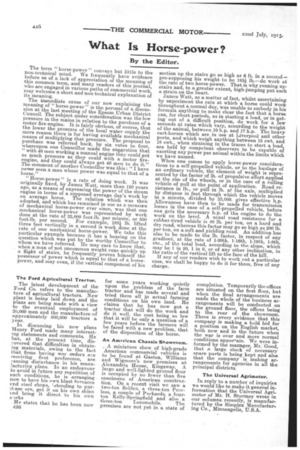What Is Horse-power?
Page 18

If you've noticed an error in this article please click here to report it so we can fix it.
By the Editor,
The term " horse-power " conveys but little to the non-technical mind. We frequently have evidence before us of a lack of appreciation of the meaning of this common term, and many readers of this journal, who are engaged in various paths of commercial work, may welcome a short and non-technical explanation of its meaning. The immediate cause of our now explaining the meaning of " horse-power" is the perusal of a discussion at the last meeting of the Epsom Urban District Council. The subject tinder consideration was the low pressure in the mains in relation to the purchase of a motor fire-engine. It is fairly obvious, of course, that the lower the pressure of the local water supply the more reason there is for having available mechanical means of multiplying that pressure. The proposal to purchase was referred back, by six votes to four, whereupon one Councillor made the suggestion that "with 40 men working a manual engine they could get as much pressure as they could with a motor fireengine, and they could always get 40 men to do it," The comment of another Councillor was this : " I have newer seen a man whose power was equal to that of a horse."
" Horse-power " is a rate of doing work. It WM originally fixed, by James Watt, more than 120 years ago, as a means of expressing the power of the steam engine in terms of a supposed average day's work by an average horse. The relation which was then adopted, and which has remained in use as a measuce of mechanical horse-power ever since, was that one mechanical horse-power was represented by work done at the rate of 33,000 foot-lb. per minute, or 550
foot-lb. per second. For example, 183k lb. lifted three feet vertically in a second is work clone at the rate of one mechanical horse-power. We take this particular example because it has a bearing on the question which was put by the worthy Councillor to whom we have referred. He may care to know that, when a man of not uncommon weight runs quickly up a flight of stairs, he frequently proves himself the possessor of power which is equal to that of a horsepower, and may even, if the vertical component of his motion up the stairs go so high as 6 ft. in a, secondpre-supposing his weight to be 1831lb.—do work at the rate of two horse-power. That is why running upstairs and, to a greater extent, high-jumping put such a strain on the heart.
James Watt, as a matter of fact, whilst ascertaining by experiment the rate at which a horse could work throughout a normal day, was unable to embody in his formula anything to make clear the fact that a horse can, for short periods, as in starting a load, or in geting out of a difficult position, do work for a few seconds at rates which vary, according to the weight of the animal, between 10 h.p. and 17 h.p. The heavy cart-horses which are in use at Liverpool and other ports, and which weigh anything between 15 cwt. and 18 cwt., when straining in the traces to start a load, are held by competent observers to be capable of exerting any power per animal within the limits which we have named.
When one comes to apply horse-power considerations to a self-propelled vehicle, or to the haulage of an ordinary vehicle, the element of weight is represented by the factor of lb. of propulsive effort applied at the rim of the wheels, or in the case of a rolling vehicle -of pull at the point of application. Road resistance in lb., or pull in lb. at the axle, multiplied by distance in feet through which the vehicle moves in a minute, divided by 33,000. gives effective h.p. Allowances have then to be made for transmission losses in the case of a self-propelled vehicle, before one gets the necessary h.p. of the engine to do the work on the level. A usual road resistance for a rubber-tired vehicle is 40 lb. per ton, on a hard and dry road, whereas this factor may go so high as 200 lb. per ton, on a soft and yielding road. An addition has also to be made to the lb. factor, in respect of any gradient, at the rate of 1-20th, 1-16th, 1-12th, 1-9th, etc., of the total load, according to the slope, which may be 1 in 20, 1 in 9, or of any other inclination, in the ratio of the vertical lift to the face of the hill.
If any of our readers wish to work out a particular case, we shall be happy to do it for them, free of any . charge.






















